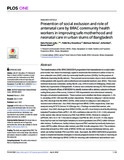| dc.contributor.author | Jolly, Saira Parveen | |
| dc.contributor.author | Chowdhury, Tridib Roy | |
| dc.contributor.author | Rahman, Mahfuzar | |
| dc.contributor.author | Alam, Ariful | |
| dc.contributor.author | Afsana, Kaosar | |
| dc.date.accessioned | 2022-04-13T06:25:47Z | |
| dc.date.available | 2022-04-13T06:25:47Z | |
| dc.date.copyright | 2020 | |
| dc.date.issued | 2020-07-08 | |
| dc.identifier.citation | Jolly, S. P., Chowdhury, T. R., Rahman, M., Alam, A., & Afsana, K. (2020). Prevention of social exclusion and role of antenatal care by BRAC community health workers in improving safe motherhood and neonatal care in urban slums of Bangladesh. PLoS ONE, 15(7 July 2020) doi:10.1371/journal.pone.0235340 | en_US |
| dc.identifier.uri | http://hdl.handle.net/10361/16547 | |
| dc.description | This article was published in The Plos One [ © 2020 Jolly et al. This is an open access article distributed under the terms of the Creative Commons Attribution License] and the definite version is available at: https://doi.org/10.1371/journal.pone.0235340 The Journal's website is at: https://journals.plos.org/plosone/article?id=10.1371/journal.pone.0235340 | en_US |
| dc.description.abstract | The transformation of the BRAC MANOSHI programme from humanitarian to a social enterprise model, has made it increasingly urgent to enumerate the minimum number of door-to-door antenatal care (ANC) visits by community health workers (CHWs), for the purpose of effectively improving facility delivery. Thus prevent social exclusion of poor slum communities in Bangladesh with regard to safe motherhood and essential newborn care (ENC). This cross-sectional study was conducted, during March–July, 2015 in slums of Chittagong, Dhaka and Sylhet city corporations of Bangladesh. A census was conducted among 25,700 households covering 10 branch offices of MANOSHI to identify women with a delivery outcome in the preceding three years of the survey. A total of 1100 respondents were interviewed randomly through a structured questionnaire. These women were stratified into three categories-1, 2 & 3, consisting of 497, 205 and 398 women respectively. Women in category-1 did not receive any ANC checkup from the BRAC CHWs, while women in category-2 and category-3 received one to three and ≥four ANC checkups from BRAC CHWs respectively. Data was analysed using STATA Version 13 (Chicago Inc.). Findings revealed that women, who received ≥four ANC checkups from BRAC CHWs, are 25% more likely to avail facility delivery [adjusted Prevalence Ratio (aPR) 1.25; 95% confidence interval (CI) (1.01–1.54)] compared to the women who did not receive any ANC from BRAC CHWs. Women in category-2 [aPR3.64; 95% CI (1.76–7.54)] and in category-3 [aPR5.92; 95% CI (3.04–11.53)] respectively had four and six folds higher tendency to receive postnatal care (PNC) within 48 hours after delivery. Furthermore, facility delivery improved PNC assisted by medically trained providers (MTPs) within 48 hours after delivery and ENC in both categories 2 & 3. The evidence shows that at least four ANC visits of BRAC CHWs can increase institutional delivery, and which can further facilitate PNC and ENC visits. At present, the BRAC MANOSHI programme needs to implement feasible strategies to include pregnant women in the slums in receiving at least four ANC checkups by BRAC CHWs for ensuring safe motherhood and newborn care. | en_US |
| dc.language.iso | en_US | en_US |
| dc.publisher | PLOS ONE | en_US |
| dc.relation.uri | https://journals.plos.org/plosone/article?id=10.1371/journal.pone.0235340 | |
| dc.subject | Prevention of social exclusion | en_US |
| dc.subject | Antenatal care | en_US |
| dc.subject | BRAC community health workers | en_US |
| dc.subject | Safe motherhood | en_US |
| dc.subject | Neonatal care | en_US |
| dc.subject | Urban slums of Bangladesh | en_US |
| dc.title | Prevention of social exclusion and role of antenatal care by BRAC community health workers in improving safe motherhood and neonatal care in urban slums of Bangladesh | en_US |
| dc.type | Journal Article | en_US |
| dc.description.version | Published | |
| dc.contributor.department | Brac James P. Grant School of Public Health | |
| dc.identifier.doi | https://doi.org/10.1371/journal.pone.0235340 | |

